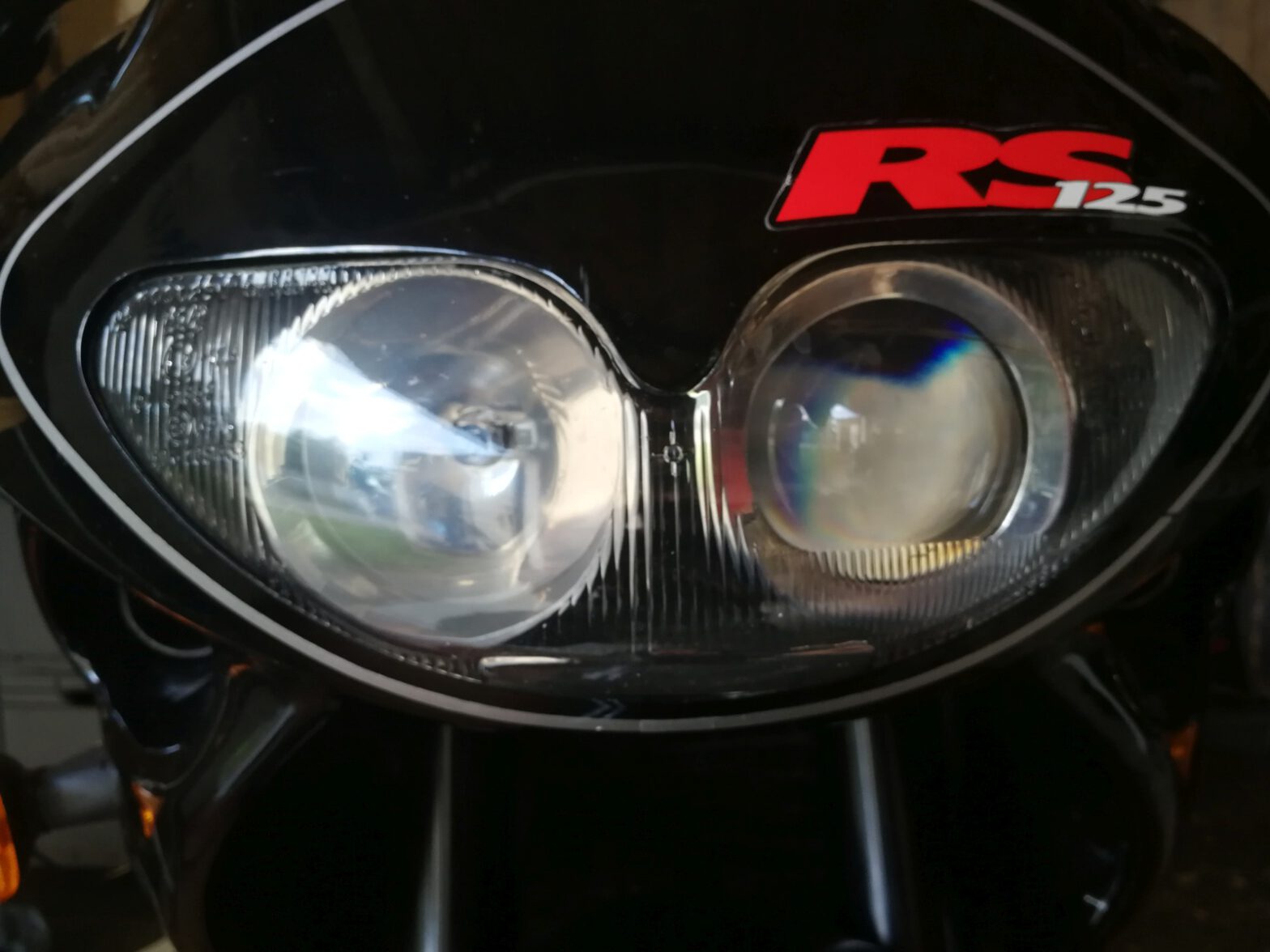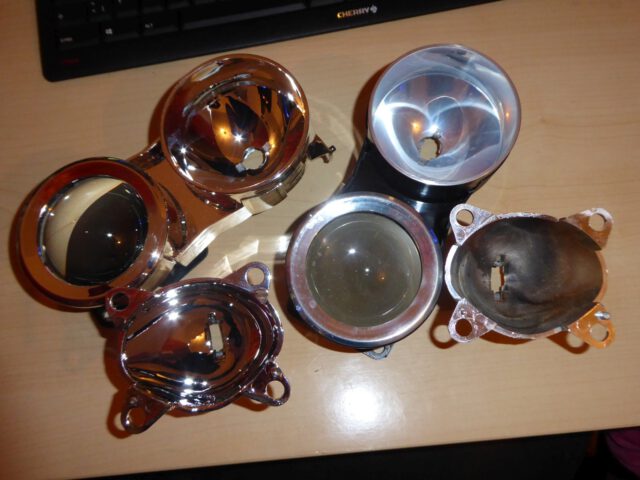Unfortunately, the low and high beam on my Aprilia RS 125 and RS 250, both built in 1998, are not comparable to newer vehicles when it comes to headlight brightness. The question comes up: What can be done to give the RS 125 better lighting? How do Osram Night Breaker or retrofit LED bulbs actually perform? Can they be easily installed?
In this article, I have tried to test many of the light bulbs available on the market for this specific headlight. The results are only partially transferable to other vehicles. For those who do not want to read the entire article, here are the results in one image:
The low beam is a projection lens headlight with an H1 halogen lamp and 55 watts that illuminates the required area to the sides. The high beam is a mirror headlight with an H3 halogen lamp also with 55 watts that illuminates a circular area in the distance. The high beam definitely has weaknesses to the sides. Nighttime driving with high beam is actually dangerous because the area where one will be driving immediately is not illuminated. Accordingly, the question of how to improve the lighting is legitimate.
Lights
For this article and test, I tried to purchase various H1 and H3 bulbs for the headlight of the Aprilia RS 125 up to 2005 and RS 250. Ultimately, availability was the deciding purchasing factor.

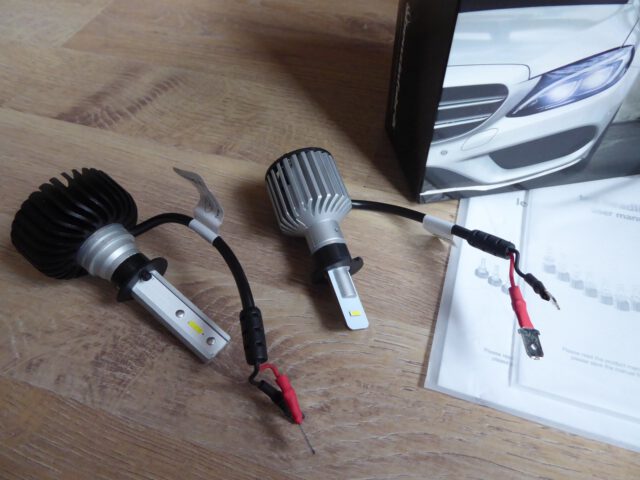
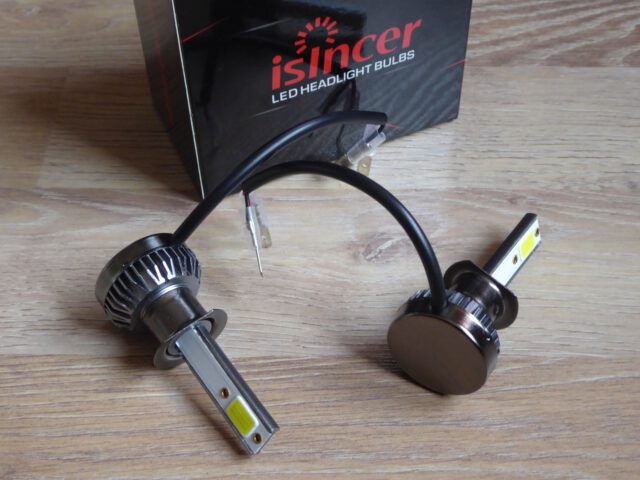

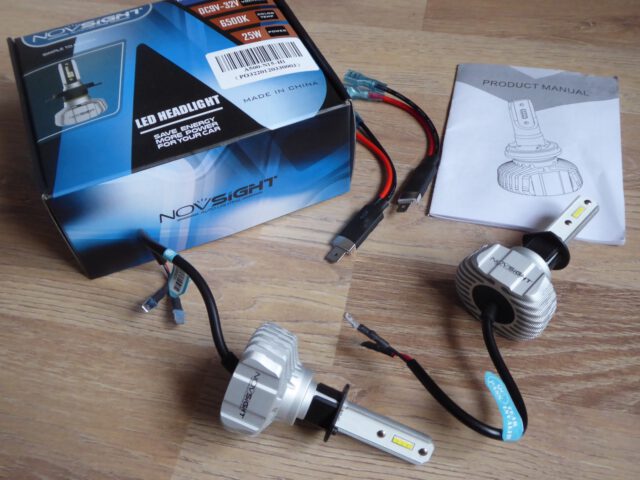
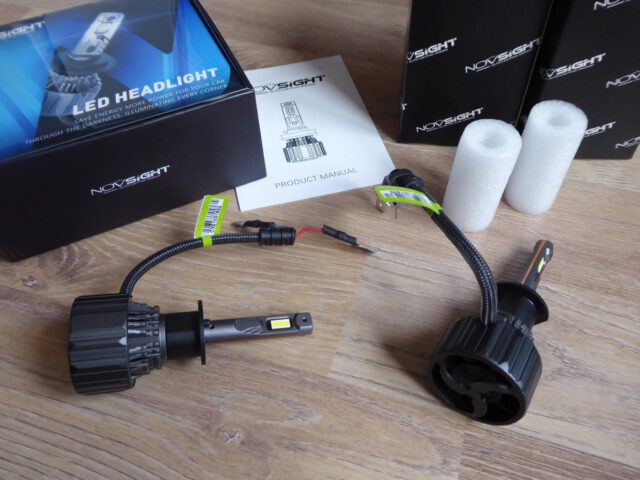
For the low beam, I ordered four different halogen bulbs and nine different LED lights with an H1 base. In addition to the two popular stronger bulbs Osram Night Breaker Laser H1 and Philips X-treme Vision Pro150, I also searched for “H1 Xenon Look” and bought the first bulb that was suggested to me, which was “Brehma Cool White Ultra.” From the manufacturer Nighteye and Novsight, I was able to order five different led lights for H1, and another manufacturer from China was “iSincer,” where I found two different led lights. There is also a slightly more expensive light from the manufacturer “Benzinfabrik,” for which I chose the passively cooled AIOX5 with slightly lower performance. I was also able to find a bulb that consists of 24 SMD LEDs for H1.
Although the following tables always indicate “price per unit,” many lights are only available as a set of two, and prices vary widely depending on the platform and offer.
| Light bulb | Power | Luminous flux | Light color | Light source | Price per unit |
|---|---|---|---|---|---|
| Brehma Cool White ultra | 55 W | – | 5000 K | Halogen | 2,50 € |
| Osram Night Breaker Laser H1 | 55 W | 1.550 lm | 3200 K | Halogen | 13,99 € |
| Philips X-treme Vision Pro150 | 55 W | 1.550 lm | 3450 K | Halogen | 10,77 € |
| Nighteye A338-B-H1S | 80 W | 800 lm | 6500 K | 6x CSP-LED | 10,00 € |
| Noname H1 24 SMD | – | – | 6500 K | 24x SMD | 2,74 € |
| Novsight A379-F9-H1 | 80 W | 1.000 lm | 6.000 K | Tyanshine 1860 | 10,00 € |
| Novsight A500-N15-H1 | 25 W | 5.000 lm | 6.500 K | SEOUL CSP Y19 | 20,90 € |
| Novsight A500-N35-H1 | 25 W | 5.000 lm | 6.000 K | Tyanshine Chips | 14,95 € |
| Novsight A500-N50-H1 | 35 W | 7.500 lm | 6.500 K | „Automotive grade chips“ | 19,50 € |
| iSincer 2857247 | 55 W | 1.300 lm | 6.500 K | COB | 6,50 € |
| iSincer 2859966 | 110 W | 5.000 lm | 7.000 K | COB | 5,98 € |
| Benzinfabrik LEDH1 V3.0 AIOX5 | 18 W | 2.000 lm | 6.000 K | 6x CSPy19x12 | 59,98 € |
For the H3 base, the selection is significantly smaller. Here again, there are the Osram Night Breaker Laser H3, a bulb with 24 SMD LEDs, and two models from Novsight, which were also available as H1 bulbs. At Benzinfabrik, there are several models. Since this is about the high beam, I ordered the actively cooled LEDH3 AIOX8 there.
| Light bulb | Power | Luminous flux | Light color | Light source | Pirce per unit |
|---|---|---|---|---|---|
| Osram Night Breaker Laser H3 | 55 W | 1450 lm | 3200 K | Halogen | 12,99 € |
| Noname H3 24 SMD | – | – | 6500 K | 24x SMD 4014 | 3,80 € |
| Novsight A379-F9-H3 | 80 W | 1000 lm | 6000 K | Tyanshine 1860 | 11,00 € |
| Novsight A500-N50-H3 | 35 W | 7500 lm | 6500 K | „Automotive grade chips“ | 19,50 € |
| Benzinfabrik LEDH3 AIOX8 | 23 W | 2500 lm | 5000 K | 6x CSPy19x12 | 74,98 € |
You could now list each bulb individually and try to talk about various points that sound important. I will not waste your time with this, so now here are the first noticeable features:
The Novsight A500-N50-H1 and A500-N50-H3, as well as the Benzinfabrik LEDH3 AIOX8, are actively cooled with a fan, all other bulbs are passive, some with larger heat sinks.
It is immediately noticeable that Novsight A379-F9-H1 and A379-F9-H3, as well as Nighteye A338-B-H1S, have the absolutely failed in putting the light source where it belongs. This is too bad, because these are the models without heat sinks that could otherwise be exchanged plug & play.
The two lights from iSincer cannot be precisely reinstalled on this headlight, as the noses on the mounting surface of the holder are missing. Ironically, shortly after purchasing the product, eBay warned me of potential risks regarding product safety or counterfeit items, and deleted the listings from their platform. The product was advertised to have a heat pipe for cooling, which does not exist, and the technical specifications listed in different places for the same product are completely inconsistent. Additionally, the listed technical specifications vary greatly between different sellers. For example, at one point it was stated that the light had 10,000 lumens and 200 watts, which is impossible for a single bulb. I leave it up to you to evaluate the credibility of such claims.
Headlight
As mentioned earlier, the headlight tested here is a combination of a projection lens headlight for low beam and a reflector headlight for high beam.This is a relatively fortunate combination, as will be shown.
Since the reflectors tend to become somewhat bleached after a certain age, I had them recoated before this test.
Fortunately, I had dismantled and repaired a spare headlight, so when I removed the old headlight, I found that the reflector for the low beam had already deformed and melted due to the heat of the halogen lamps. This was also a reason for poor lighting, but I had passed the inspection with the melted reflector. The following pictures show the inside of the projection lens headlight.
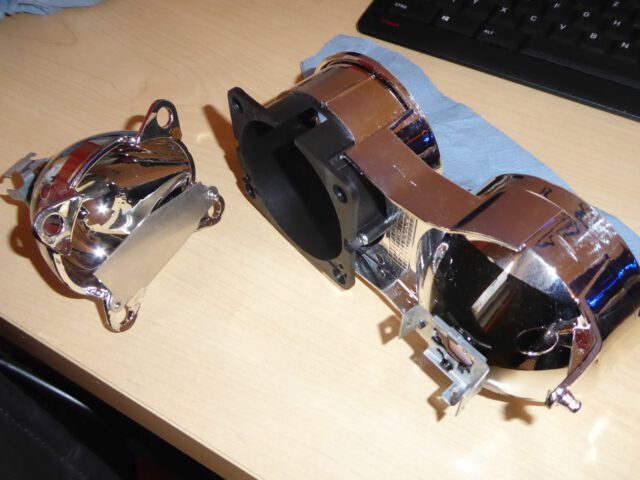
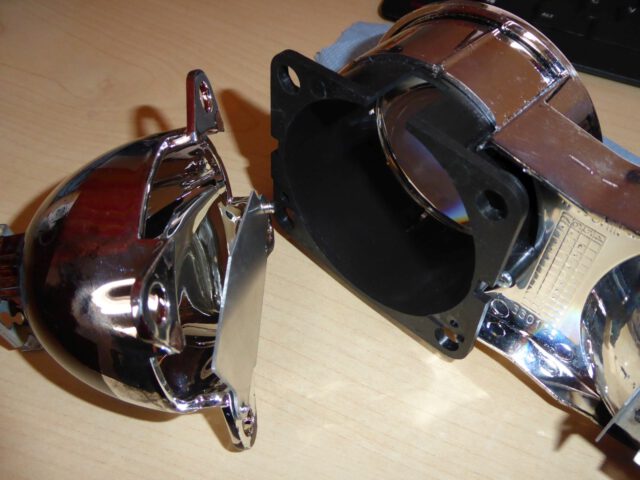
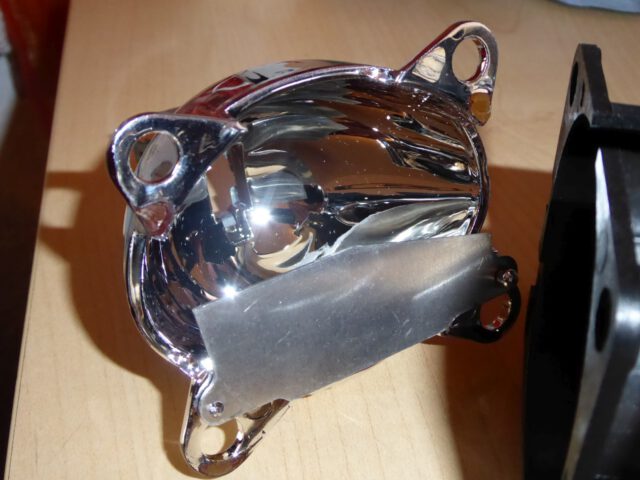
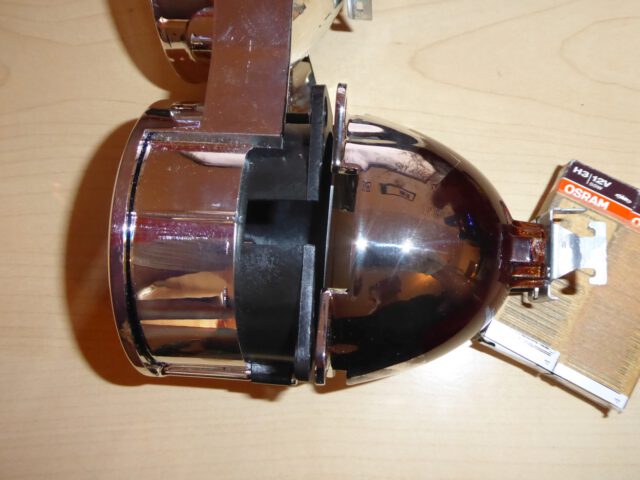

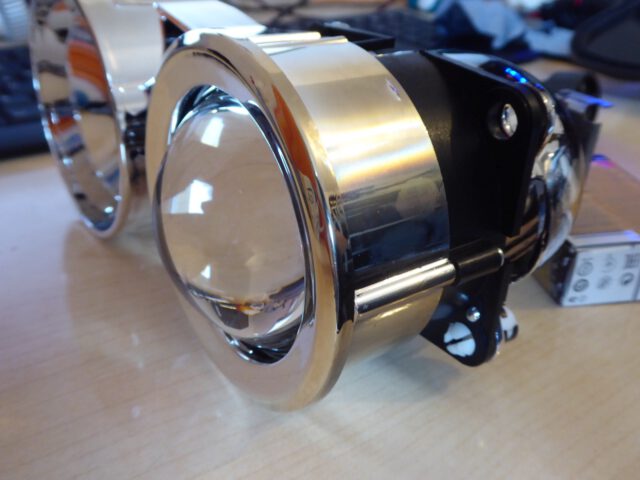
Legal Restrictions
As mentioned at the beginning, both the headlight itself and the individual light sources must be approved for use in accordance with regulations for lighting systems. Original equipment parts or approved replacement lamps usually bear the corresponding ECE certification mark.

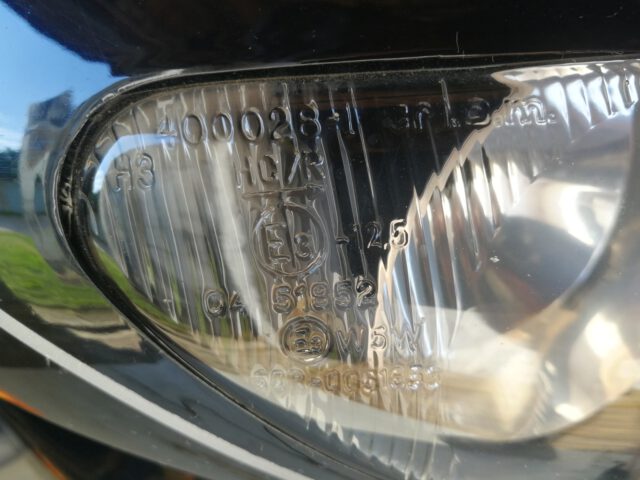

Halogen lamps that are advertised as providing better light include Osram Night Breaker Laser (H1 and H3) or Philips X-treme Vision (H1) and Philips Vision (H3). If such light sources have the appropriate labeling, they are approved for use on public roads and can be used without hesitation.

In general, lighting systems on vehicles must be tested and approved according to UN/ECE regulations, which are also incorporated into national law, such as the German StVZO. Halogen headlights, such as those found on the Aprilia RS 125, are approved under ECE-R-8 regulations, where Halogen light sources with H1 or H3 fittings are specifically listed as part of the approval process. Headlights and light sources are always tested together.
Installing a different light source than intended, such as retrofit LED lights, will inevitably result in the headlight losing its approval if the non-standard light source is not specifically approved for this headlight and vehicle. Such approval may be a general type approval (in Germany for example it’s ABG) for the product, or approval under other EU regulations (EC type approval).
A technical inquiry to TÜV Nord on this topic resulted in the following (thank you at this point): a “simple” entry into the vehicle documents using an individual approval is not possible for non-approved lighting. A prerequisite for approval via individual approval is an approval from a lighting technical institute on the specific combination of headlight and bulb. However, with many bulbs and headlights, a positive result is not to be expected. Such an approval can also be commissioned without the involvement of the bulb manufacturer. As of today (July 2021), there is only one approved retrofit LED bulb from the manufacturer Osram (Night Breaker H7 LED), which has been approved for only a few individual headlights that required significant development work. So, it is not prohibited in principle, nor is it very easy, as is often stated on many internet pages, but in practice, it is simply not realistic.
A modification of such a headlight as that of the Aprilia RS 125 to non-approved bulbs always results in the loss of operating approval.
If such non-approved bulbs are discovered at police check, it is at the discretion of the officer as to what happens next. Everything is possible, from a verbal warning to suspension due to a danger to road traffic, including significant fines.
Using LED retrofit lights in real life
One might think that it shouldn’t be a problem to design LED lights that at least fit somewhat and function well despite lacking approval. However, this is far from the truth, as there is, as so often, an incredible amount of garbage to buy. They advertise with the usual cliches and empty words such as “high quality,” “precise fit,” “exclusive,” and the usual stupid talk. Supposedly, the light source is always in the right position.
The reality is something entirely different: Some LED retrofit bulbs cannot even be installed because they are already much larger in diameter than normal H1 bulbs due to some front-end components and mirrors. They no longer fit through the receptacles on the headlight. I would have liked to test many of these lamps to show the actual light output here, but that was simply not possible.
A much more serious problem is that the geometry of the headlight is designed to reflect the light of a filament and thereby achieve the desired illumination of the road. If the light source is in a different location, a different area of the road is illuminated (or something entirely different). In a projection lens headlight, like the low beam tested here, the light is collected by a reflector and the bright-dark limit is formed with an aperture. The image of the aperture is projected onto the road via a lens. In contrast, the reflector headlight of the high beam directs the light from the light source onto the road solely through its reflector, and the slightest deviations at the light source lead to major deviations in the light itself.
If the low beam were designed as a reflector headlight, it would be possible that, with non-approved bulbs, the bright-dark limit is no longer observed and oncoming traffic is blinded. In this case, there is a danger to road safety, and the vehicle can be immobilized on the spot. By the way, this blinding of oncoming traffic is not only dangerous but also a clear indication to the blinded driver of unauthorized modifications to the vehicle. This makes one eligible for traffic controls. By the way, even if there is no apparent danger, the police can still assume a risk and immobilize the vehicle due to the lack of approval. In this situation, being a smart aleck is of no use, the officers hold the upper hand, and your ride is over.
Test and comparison
For comparison, all light bulbs were mounted in the headlight one after the other and connected to a freshly charged battery. In a darkened room, a white wall was illuminated at the same distance each time, and the light was photographed with a digital camera. Exposure time, aperture setting, white balance, and ISO sensitivity were manually adjusted and are almost identical for all shots: For the three weakest bulbs, the exposure time had to be extended, as otherwise a completely black image would have been produced. However, these bulbs are not up for consideration for installation.
H1 Light sources
Pictures of all used H1 light sources inside projector lens headlight.
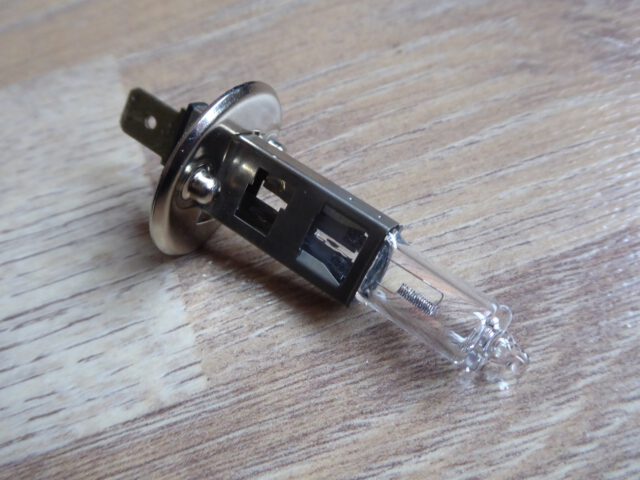

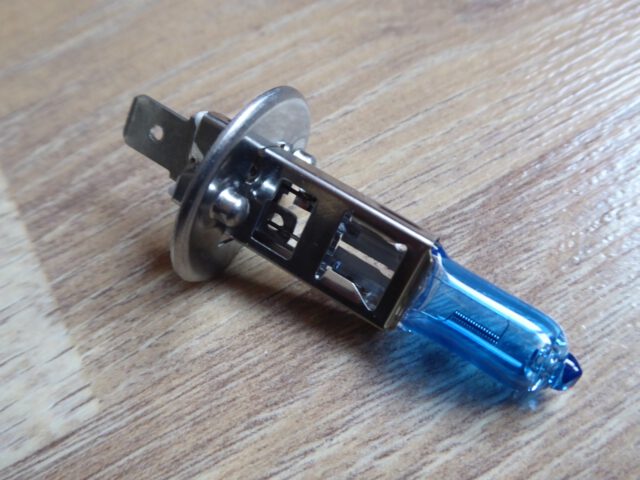
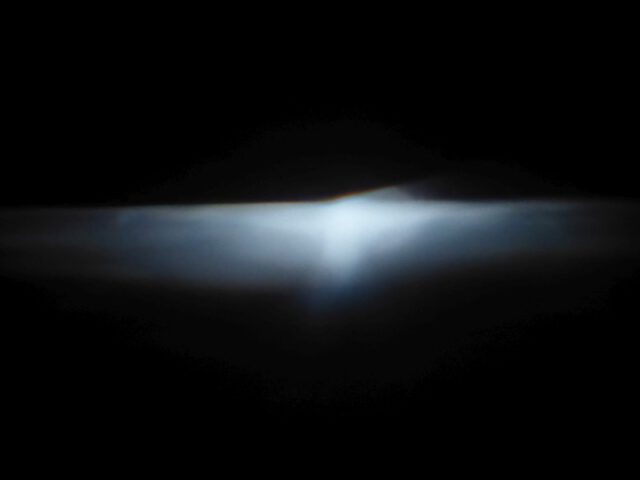

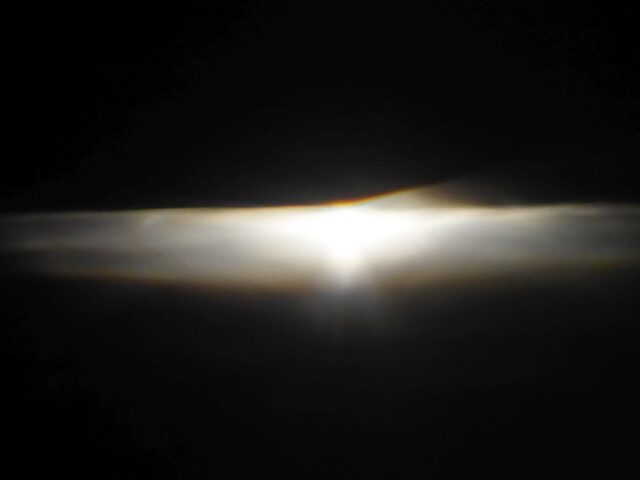


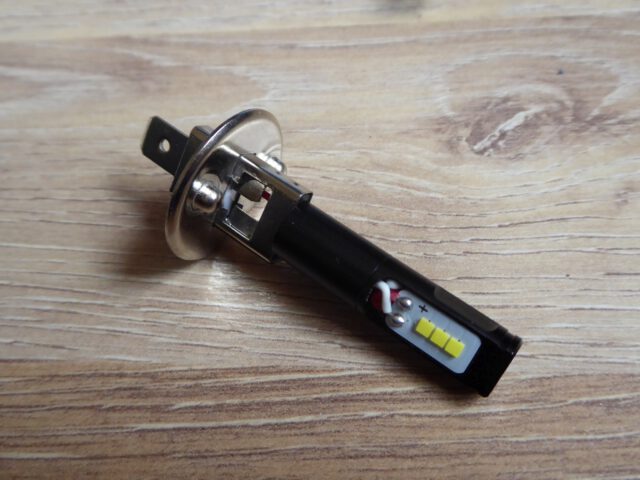
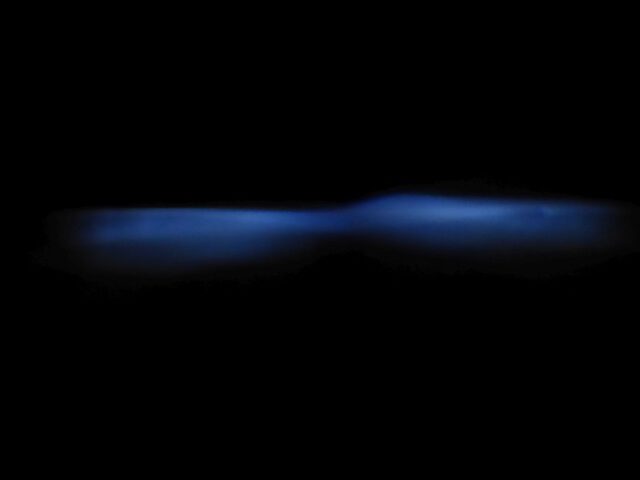
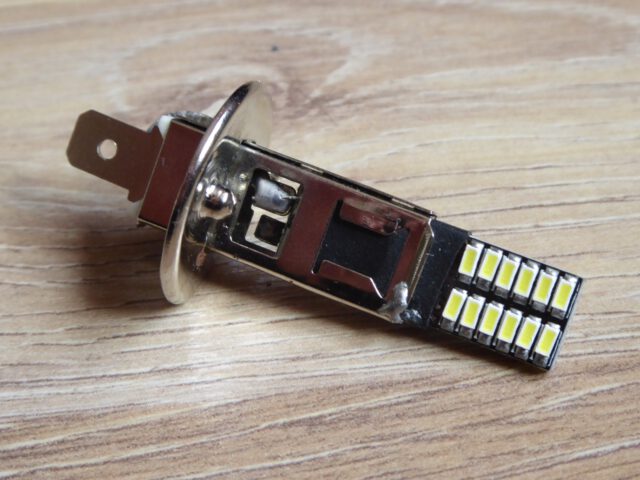

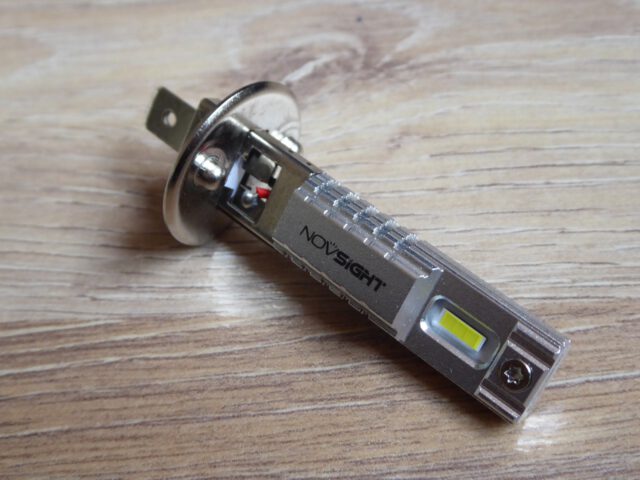
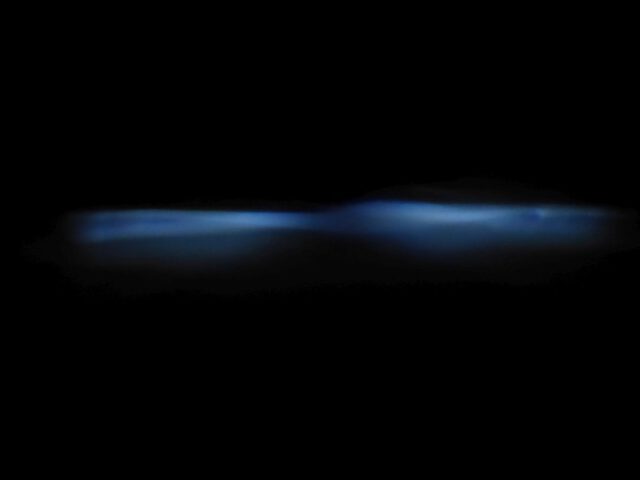

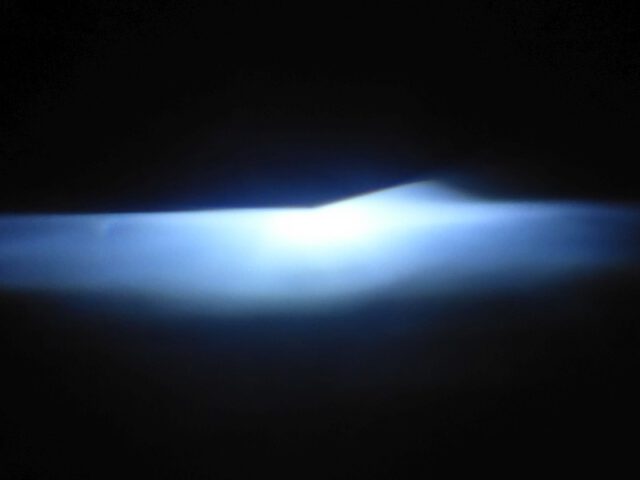
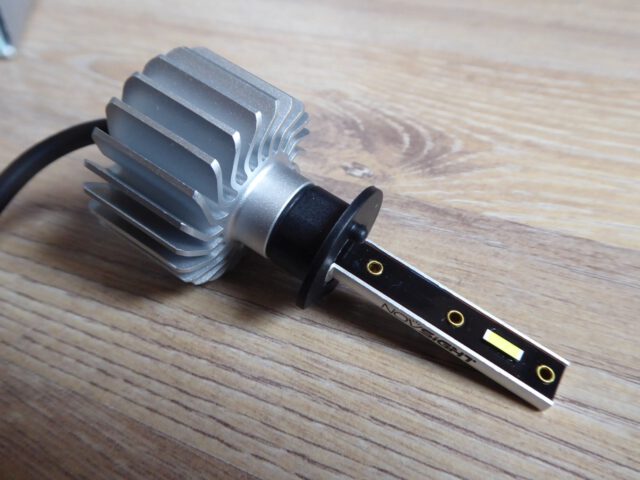
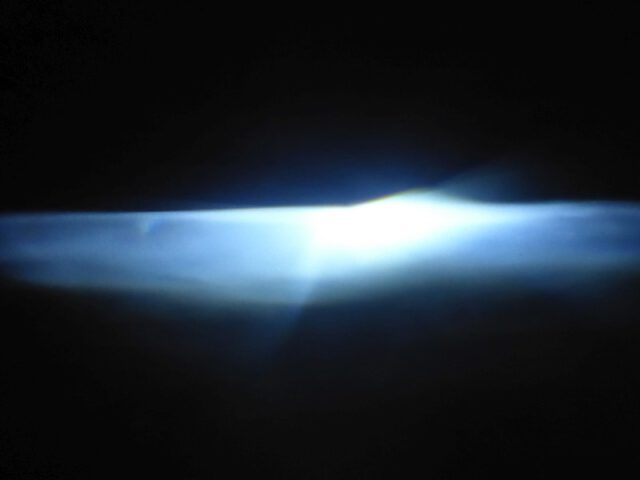
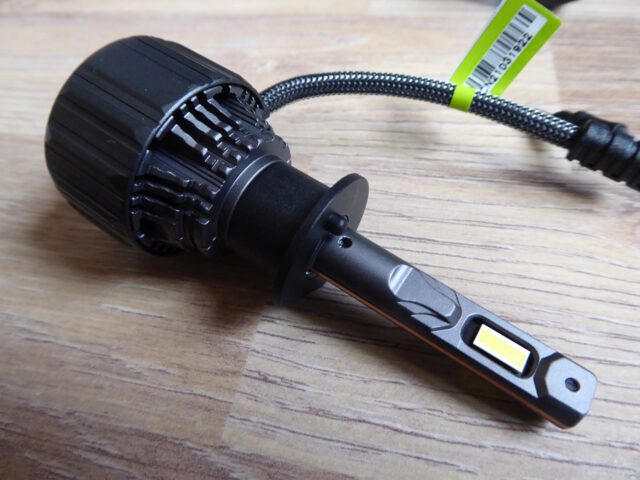
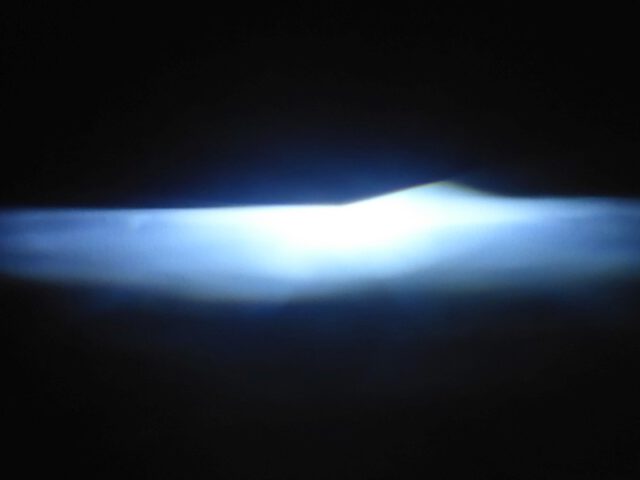
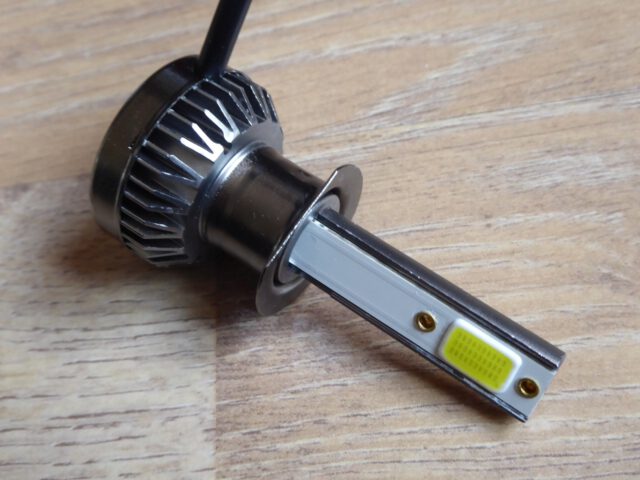
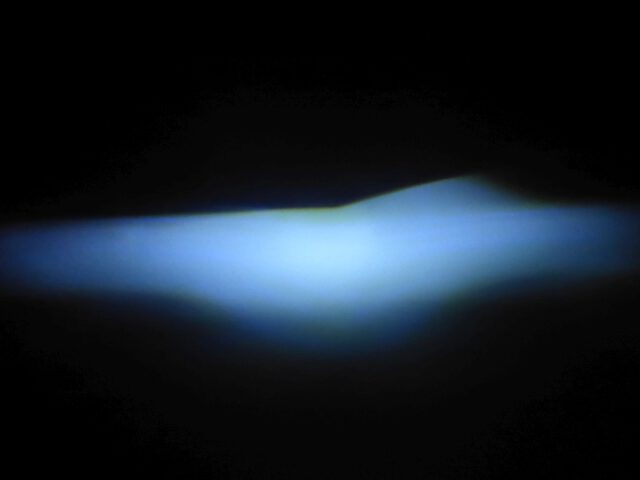

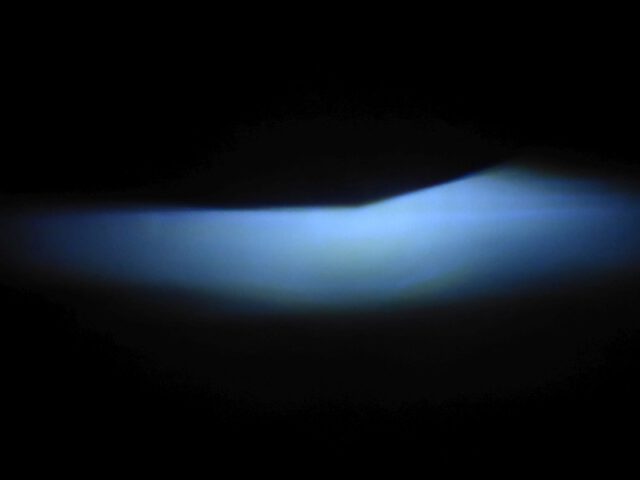

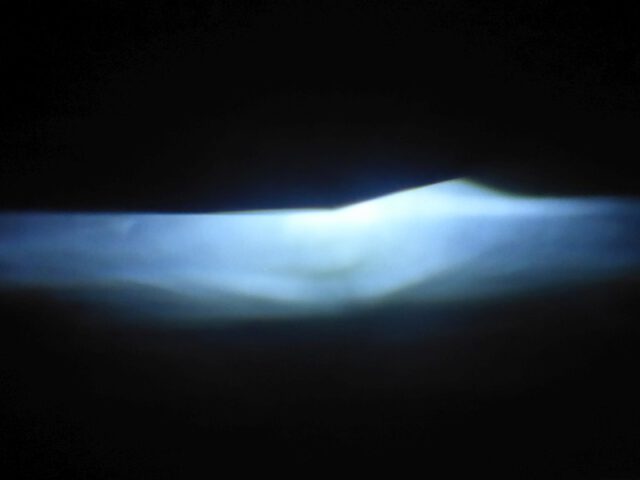
It is noticeable that there are actually no problems with the light-dark boundary in the low beam, mainly because it is a projection lens headlight and the light-dark boundary is achieved through a diaphragm, not solely through the reflector geometry.
The differences between the cheaper halogen lamps and the high-end models are immediately visible.
Some candidates immediately disqualify themselves here, the completely too dark images do not require any further explanation. The two Isincer lights and especially the three lights without a heat sink Nighteye A338-B-H1S, Noname H1 24 SMD and Novsight A379-F9-H1 are far too dark. These lamps are life-threatening.
During the tests, I measured the current consumption of all light sources, and then measured the geometry of the light source. The current readings are unfortunately somewhat inaccurate (about 0.1 A measurement uncertainty), and the light source was also measured “only” with the caliper.
| Light bulb | Current |
|---|---|
| Noname Halogen H1 | 3,8 A |
| Brehma Cool White ultra | 3,8 A |
| Osram Night Breaker Laser H1 | 4,0 A |
| Philips X-treme Vision Pro150 | 3,8 A |
| Nighteye A338-B-H1S | 0,2 A |
| Noname H1 24 SMD | 0,1 A |
| Novsight A379-F9-H1 | 0,2 A |
| Novsight A500-N15-H1 | 1,2 A |
| Novsight A500-N35-H1 | 1,4 A |
| Novsight A500-N50-H1 | 2,0 A |
| iSincer 2857247 | 1,0 A |
| iSincer 2859966 | 1,0 A |
| Benzinfabrik LEDH1 V3.0 AIOX5 | 1,4 A |
It was expected that the clearly too weak lights would also consume little power. However, it can also be seen that the LED bulbs require only about 1/3 to 1/2 of the power of the halogen lamps, which is a significant advantage for the RS 125.
Interestingly, the geometry of the light source is now actually of interest. Many manufacturers advertise that they accurately replicate the position, but the measurement results say something completely different here.
The position of the light source center to the base contact surface was measured, as well as the geometry of the light source, with length and width being the dimensions of the light source from the top and height being the distance from the front to the back surfaces of the light source.
| Light bulb | Position | Length | Width | Height |
|---|---|---|---|---|
| Reference: Halogen light bulb | 27,0 mm | 4,7 mm | 1,4 mm | 1,4 mm |
| Nighteye A338-B-H1S | 35,0 mm | 6,0 mm | 1,8 mm | 5,6 mm |
| Noname H1 24 SMD | 30,5 mm | 11,0 mm | 7,5 mm | 3,7 mm |
| Novsight A379-F9-H1 | 35,0 mm | 5,0 mm | 1,6 mm | 3,6 mm |
| Novsight A500-N15-H1 | 27,4 mm | 7,8 mm | 1,8 mm | 4,0 mm |
| Novsight A500-N35-H1 | 27,5 mm | 5,2 mm | 1,8 mm | 4,3 mm |
| Novsight A500-N50-H1 | 28,0 mm | 6,5 mm | 2,2 mm | 4,0 mm |
| iSincer 2857247 | 27,0 mm | 8,3 mm | 5,3 mm | 4,5 mm |
| iSincer 2859966 | 26,5 mm | 8,0 mm | 3,7 mm | 4,1 mm |
| Benzinfabrik LEDH1 V3.0 AIOX5 | 27,3 mm | 5,6 mm | 1,6 mm | 4,2 mm |
To be fair, it should be mentioned that providing a decimal point is critical since the measurement with the caliper without fixed contact surfaces is sometimes very inaccurate (estimated 0.5 mm uncertainty).
The Benzinfabrik LEDH1 V3.0 AIOX5 has the smallest deviations here, and the Novsight A500-N15-H1 and A500-N35-H1 also do relatively well. However, all LED bulbs are significantly too high! The construction of LEDs on a carrier board with a metal plate in between for heat dissipation is much thicker than a halogen filament. Even if the position, length, and width may seem correct at first glance, with the measured large height deviations, there is likely to be a significant deviation in light distribution in reflector headlights.
H3 light sources
When it comes to high beam, the reflector headlight, it becomes clear that none of the LED bulbs achieve the light distribution of the halogen lamps.
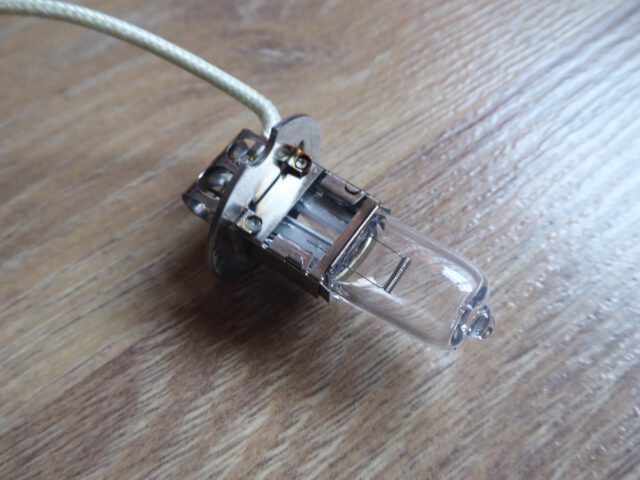
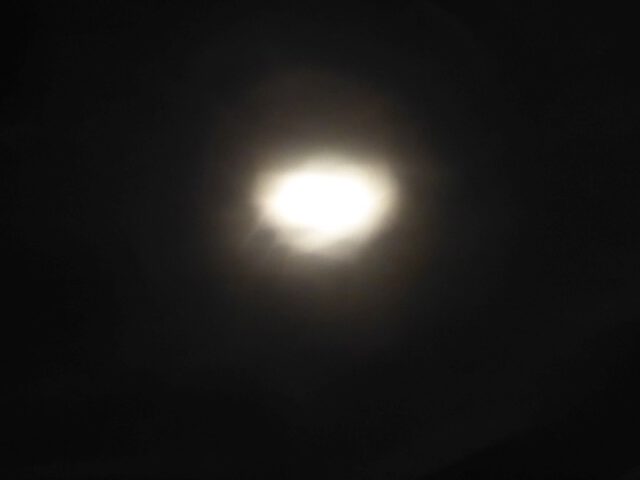
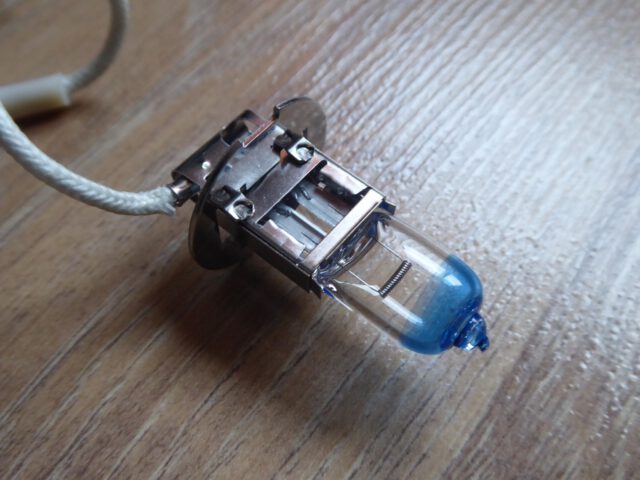



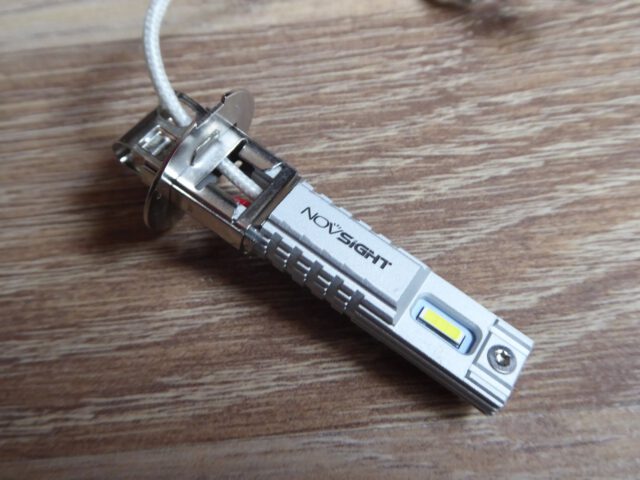

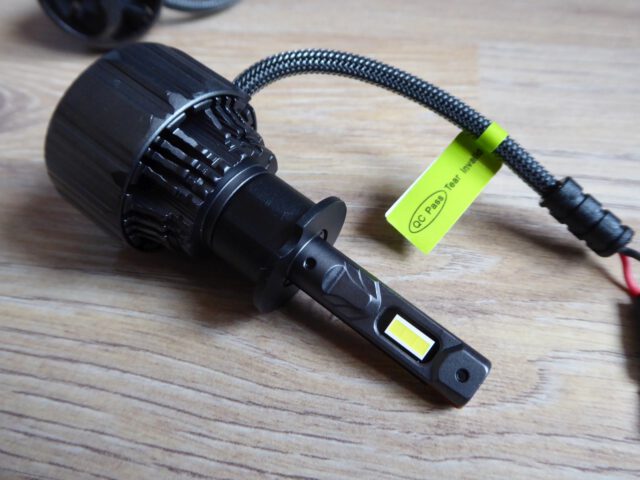
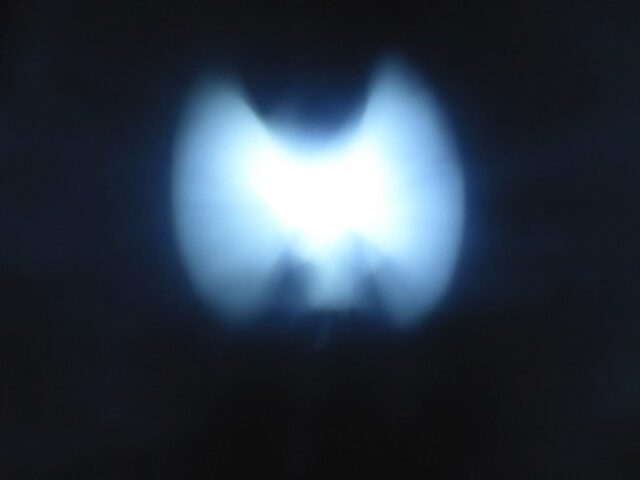
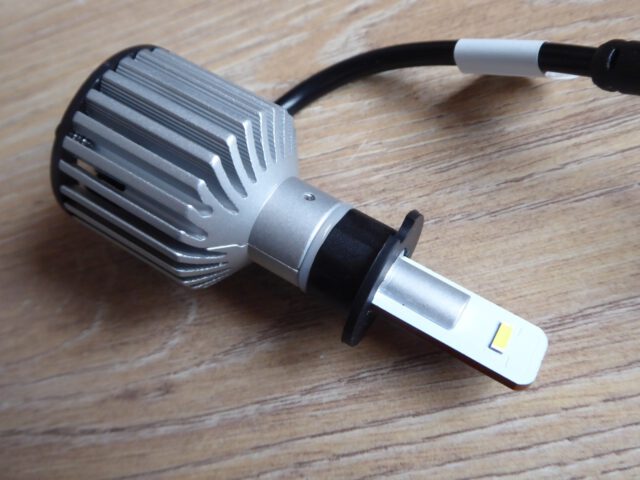
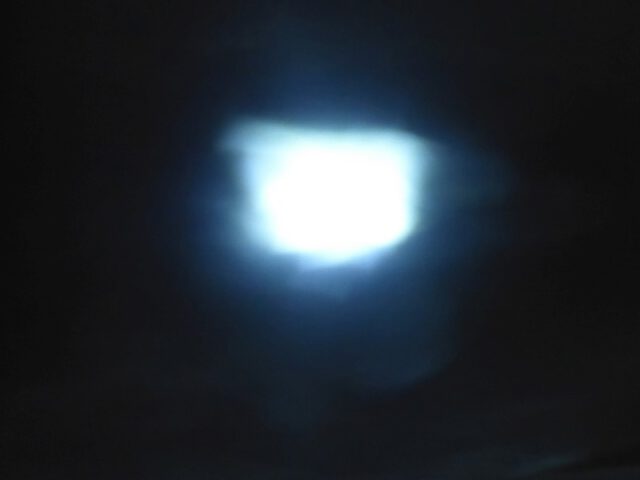
Here, two bulbs are immediately disqualified as the light source is in the completely wrong position and the light is significantly too weak. My verdict is: life-threatening.
The images also show that the deviation in light distribution among the individual bulbs is extreme, while the projection lens headlight still somehow projected the light to the right spot despite high deviations in the light source.
The power consumption offers little surprises.
| Light bulb | Current |
|---|---|
| Noname Halogen H3 | 3,8 A |
| Osram Night Breaker Laser H3 | 4,0 A |
| Noname H3 24 SMD | 0,4 A |
| Novsight A379-F9-H3 | 0,2 A |
| Novsight A500-N50-H3 | 2,0 A |
| Benzinfabrik LEDH3 AIOX8 | 1,6 A |
As with the H1 bulbs, the geometry of the light source was measured, and the results are also disappointing here.
| Light bulb | Position | Length | Width | Height |
|---|---|---|---|---|
| Reference: Halogen light bulb | 18,0 mm | 1,4 mm | 5,0 mm | 1,4 mm |
| Noname H3 24 SMD | 26,0 mm | 11,0 mm | 8,5 mm | 3,5 mm |
| Novsight A379-F9-H3 | 37,0 mm | 5,0 mm | 1,6 mm | 3,6 mm |
| Novsight A500-N50-H3 | 21,0 mm | 6,5 mm | 2,2 mm | 4,0 mm |
| Benzinfabrik LEDH3 AIOX8 | 18,0 mm | 1,6 mm | 5,0 mm | 3,1 mm |
Only the Benzinfabrik LEDH3 AIOX8 manages to replicate the position of the light source. The Novsight A379-F9-H3 and the Noname H3 24 SMD, of course, have the advantage that oncoming traffic is guaranteed not to be dazzled, as there is simply no light. The Novsight A500-N50-H3 has an extremely bright light, but due to the differing geometry in the reflection headlight, the light scatters too much. Although this is the high beam, which might not be so dramatic in terms of glare, the illuminance in the distance is also weaker.
Installation in the vehicle
If it is advertised in some places that installation is plug-and-play, it usually has to be called a lie. The heat sinks of the LED lights require space, the electrical connections do not fit, and the original caps cannot be used anymore. It says in the manual that larger caps should be used if necessary – that’s nice, but unfortunately they would have to exist at all for it to work.
For the Aprilia RS 125/250, I designed new caps from flexible material and printed them with a 3D printer.
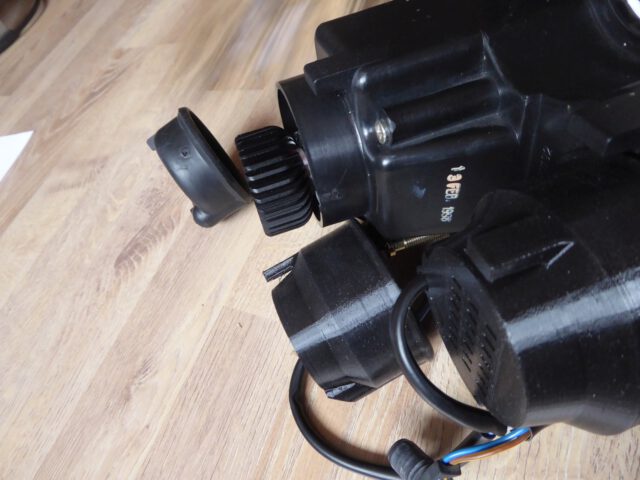
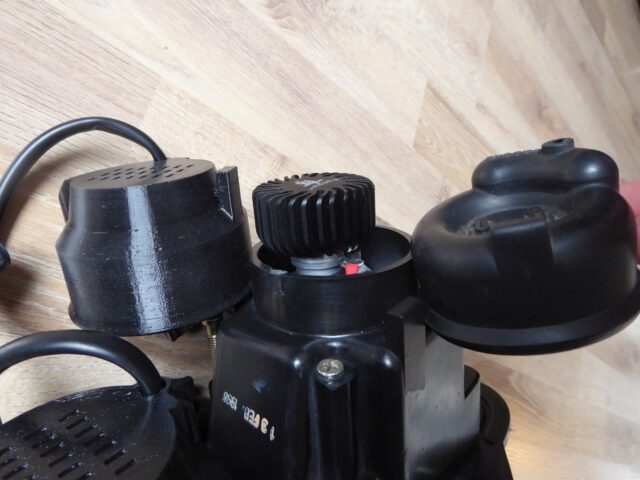

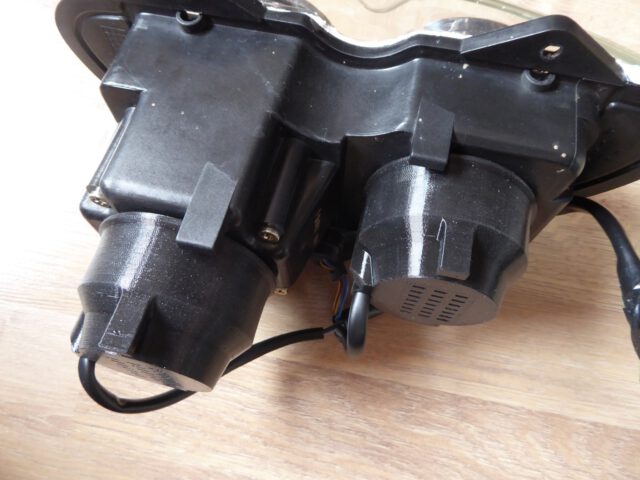
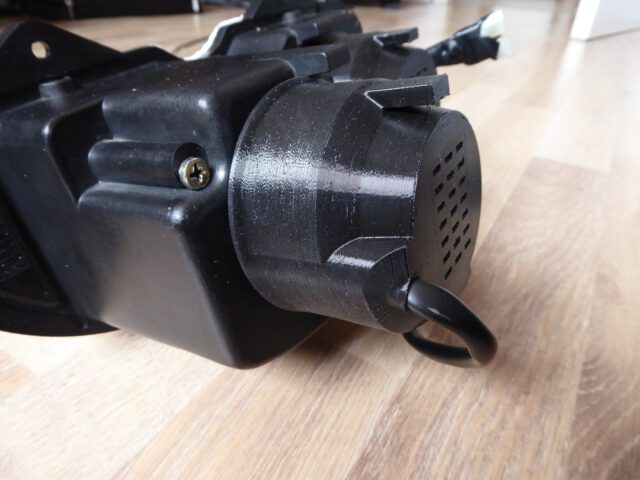
You can find the .STL-File on Thingiverse or download it here:
Conclusion
If you want to legally get more light out of an older halogen headlight, your only option is to use higher quality halogen lamps such as Orsam Nightbreaker Laser or Philips X-treme Vision Pro150. The differences from cheaper halogen lamps are clearly visible. Restoring the headlight reflectors will also undoubtedly help to improve light output.
When it comes to installing retrofit LED bulbs, it is already a challenge that the stronger LED bulbs often do not fit under the cover. If there is no solution available on the market and you cannot help yourself, this is already a significant disadvantage. CAD and 3D printing are not available to everyone and have nothing to do with “easy retrofitting.”
Some LED bulbs are practically no danger to oncoming traffic when used in the projection lens headlight tested here, but theoretically, this cannot be ruled out. A check after installation through a before-after comparison like the one here or with better measuring devices is essential. While this will not make it legal, this article clearly shows that an extreme amount of junk is being sold and it is not advisable to experiment with it on the road.
For the Aprilia RS 125, my recommendation for a projection lens headlight is the Benzinfabrik LEDH1 V3.0 AIOX5. The light output is similar to that of a halogen lamp, with the least amount of bluish tint. However, those deterred by the high price can also opt for Novsight’s A500-N35-H1 or A500-N15-H1, which are also great options. The actively cooled A500-N50-H1 were the most powerful tested headlights for low beam, significantly brighter than halogen lamps, but they do show some light above the high-low beam cut off, which is also present in halogen lamps.
One major advantage of all retrofit LED headlights is their lower power consumption, which allows for parallel operation of low and high beams. Avoiding burnt reflectors is also a significant advantage of LED headlights. However, a few photos on an internet blog are not evidence that possible glare of oncoming traffic can be ruled out. Installing retrofit LED headlights definitely leads to the revocation of the operating permit. It’s unfortunate that there isn’t an easy way to register the headlights, especially for projection lens headlights, because the significantly better light output is definitely a safety benefit for the driver.
For reflector headlights, the differences in light distribution, although only tested here for high beams, are extreme. For the RS 125, I recommend sticking with halogen lamps, specifically the Osram Nightbreaker Laser. If you want LED for the high beams, go for the Benzinfabrik LEDH3 AIOX8. However, note that the headlights are clearly visible from the outside.
I strongly advise against installing unauthorized retrofit LED headlights, especially in reflector headlights for low beams on other vehicles.

